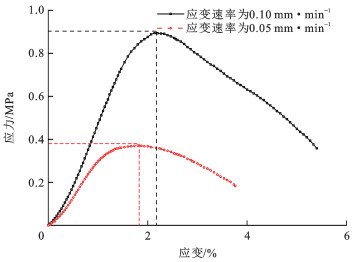Creep damage model and damage evolution of asphalt mixtures
-
摘要: 为定量描述沥青混合料的蠕变特性,考虑沥青混合料在整个蠕变过程中同时存在蠕变硬化机制和蠕变损伤劣化机制,基于分数阶微积分理论,发展了一种相对简单的分数阶蠕变损伤模型,用分数阶Maxwell模型来描述蠕变硬化机制,用损伤应变来表示蠕变损伤劣化机制,并从统计学角度推导出沥青混合料的损伤演化方程;对AC-13沥青混合料进行了不同应力水平(0.179、0.358、0.448、0.537和0.716 MPa)下的单轴压缩蠕变试验,通过Levenberg-Marquardt优化算法进行了非线性拟合,确定了不同应力水平下分数阶蠕变损伤模型的参数与损伤演化曲线;为构建不同应力水平下统一的损伤演化模型,提出了一种统计量化沥青混合料损伤演化的方法,建立了蠕变损伤与损伤应变之间的演化关系。研究结果表明:在不同应力水平下,提出的分数阶蠕变损伤模型与试验结果的判定系数均不小于0.995,适用于描述包括衰减蠕变阶段、稳定蠕变阶段和加速蠕变阶段的整个蠕变过程;在衰减蠕变阶段,不同应力水平下沥青混合料的损伤都小于1.0×10-3,相对于蠕变破坏时的损伤0.8可以忽略不计,而进入稳定蠕变阶段以后,损伤逐渐增大;当沥青混合料的蠕变应力超过一定值时会发生蠕变破坏,其流值时间取决于所施加的应力水平;用二参数Weibull分布函数拟合所得的蠕变损伤与损伤应变之间演化关系的判定系数为0.992,说明可以建立不同应力水平下的统一损伤演化模型,且其参数只与材料性能和温度有关,与施加应力大小无关。Abstract: To quantitatively evaluate the creep characteristics of asphalt mixtures, the mechanisms associated with both creep hardening and creep damage and deterioration throughout the creep process of asphalt mixtures were considered. Based on the fractional calculus theory, a relatively simple fractional creep damage model was developed. In this model, a fractional Maxwell model was used to describe the creep hardening mechanism, and the damage strain was used to represent the creep damage and deterioration mechanism. In addition, a damage evolution equation for asphalt mixtures was statistically derived. Uniaxial compressive creep tests were performed on AC-13 asphalt mixtures at different stress levels (0.179, 0.358, 0.448, 0.537, and 0.716 MPa). The nonlinear fitting was carried out using the Levenberg-Marquardt optimization algorithm to determine the parameters of fractional creep damage model as well as the damage evolution curves at different stress levels. To construct a unified damage evolution model for different stress levels, a method to statistically quantify the damage evolution of asphalt mixtures was proposed, and the evolution relationship between the creep damage and the damage strain was established. Research results show that the determination coefficients between the proposed fractional creep damage model results and the test results at different stress levels are all not less than 0.995, indicating that the proposed model is suitable for describing the entire creep process including the decay, stable, and accelerated creep stages. In the decay creep stage, the damage of asphalt mixture at different stress levels is less than 1.0×10-3 and is negligible compared to the damage (0.8) at creep failure. In the stable creep stage, the damage gradually increases. Eventually, the asphalt mixture undergoes creep failure when the creep stress exceeds a certain value. The flow time depends on the applied stress level. The determination coefficient of evolution relationship between the creep damage and the damage strain fitted by the two-parameter Weibull distribution function is 0.992. This indicates that one damage evolution model can be developed for different stress levels. Its parameters are only related to material properties and temperature and are independent of the applied stress. 2 tabs, 10 figs, 32 refs.
-
Key words:
- pavement engineering /
- asphalt mixture /
- fractional calculus /
- creep model /
- damage evolution /
- damage strain /
- Weibull distribution
-
表 1 沥青混合料集料级配
Table 1. Aggregate gradation of asphalt mixture
筛孔孔径/mm 16.000 13.200 9.500 4.750 2.360 1.180 0.600 0.300 0.150 0.075 通过率/% 100.0 96.3 77.9 46.1 40.5 31.5 18.8 11.9 9.2 6.3 表 2 不同应力水平下分数阶蠕变损伤模型的参数
Table 2. Parameters of fractional creep damage model under different stress levels
加载应力/MPa E/MPa r ξ1/(MPa·sr) ξ2/(MPa·sr) m n 判定系数R2 0.179 95.24 0.149 381.97 382.21 1.87 18 441.33 0.996 0.358 95.18 0.150 378.01 381.97 1.62 15 642.20 0.995 0.448 95.61 0.262 736.62 924.68 1.99 6 101.07 0.996 0.537 95.81 0.444 1 013.52 11 021.61 2.86 1 694.10 0.997 0.716 95.46 0.481 1 168.21 5 718.29 3.99 1 025.81 0.996 -
[1] SINGH B, SABOO N, KUMAR P. Modelling the complex modulus strain relationship of asphalt binders[J]. Petroleum Science and Technology, 2016, 34(13): 1137-1144. doi: 10.1080/10916466.2016.1190749 [2] LIU Hong-fu, YANG Xin-yu, JIANG Li-jun, et al. Fatigue- creep damage interaction model of asphalt mixture under the semi-sine cycle loading[J]. Construction and Building Materials, 2020, 251: 119070. doi: 10.1016/j.conbuildmat.2020.119070 [3] ALRASHYDAH E I, ABO-QUDAIS S A. Modeling of creep compliance behavior in asphalt mixes using multiple regression and artificial neural networks[J]. Construction and Building Materials, 2018, 159: 635-641. doi: 10.1016/j.conbuildmat.2017.10.132 [4] DONG Ni-ya, WANG Duan-yi, ZHANG Shao-wei, et al. Exploring creep and recovery behavior of hot mix asphalt field cores with multi-sequenced repeated load test[J]. Construction and Building Materials, 2021, 279: 122435. doi: 10.1016/j.conbuildmat.2021.122435 [5] LUO Wen-bo, LI Bo, ZHANG Yong-jun, et al. A creep model of asphalt mixture based on variable order fractional derivative[J]. Applied Sciences, 2020, 10: 3862. doi: 10.3390/app10113862 [6] LUO Wen-bo, JAZOULI S, VU-KHANH T. Modeling of nonlinear viscoelastic creep of polycarbonate[J]. e-Polymers, 2007, 7(1): 191-201. [7] DARABI M K, HUANG C W, BAZZAZ M, et al. Characterization and validation of the nonlinear viscoelastic- viscoplastic with hardening-relaxation constitutive relationship for asphalt mixtures[J]. Construction and Building Materials, 2019, 216: 648-660. doi: 10.1016/j.conbuildmat.2019.04.239 [8] BAI Fan, YANG Xin-hua, ZENG Guo-wei. Creep and recovery behavior characterization of asphalt mixture in compression[J]. Construction and Building Materials, 2014, 54: 504-511. doi: 10.1016/j.conbuildmat.2013.12.088 [9] SABOO N, MUDGAL A. Modelling creep and recovery response of asphalt binders using generalized burgers model[J]. Petroleum Science and Technology, 2018, 36(20): 1627-1634. doi: 10.1080/10916466.2018.1496109 [10] CHENG Yong-chun, LI He, LI Li-ding, et al. Viscoelastic properties of asphalt mixtures with different modifiers at different temperatures based on static creep tests[J]. Applied Sciences, 2019, 9(20): 4246. doi: 10.3390/app9204246 [11] 尹应梅. 基于DMA法的沥青混合料动态粘弹特性及剪切模量预估方法研究[D]. 广州: 华南理工大学, 2011.YIN Ying-mei. Research on dynamic viscoelastic characteristics and shear modulus predicting methods for asphalt mixtures based on dynamic mechanical analysis (DMA) means[D]. Guangzhou: South China University of Technology, 2011. (in Chinese) [12] LAGOS-VARAS M, MOVILLA-QUESADA D, ARENAS J P, et al. Study of the mechanical behavior of asphalt mixtures using fractional rheology to model their viscoelasticity[J]. Construction and Building Materials, 2019, 200: 124-134. doi: 10.1016/j.conbuildmat.2018.12.073 [13] 罗文波, 梁晟, 张永军. 沥青混合料动态黏弹性的分数阶微分本构模型[J]. 中国公路学报, 2020, 33(2): 34-43. https://www.cnki.com.cn/Article/CJFDTOTAL-ZGGL202002003.htmLUO Wen-bo, LIANG Sheng, ZHANG Yong-jun. Fractional differential constitutive model for dynamic viscoelasticity of asphalt mixture[J]. China Journal of Highway and Transport, 2020, 33(2): 34-43. (in Chinese) https://www.cnki.com.cn/Article/CJFDTOTAL-ZGGL202002003.htm [14] ZBICIAK A, MICHALCZYK R, BRZEZI AN'G SKI K. Time- temperature superposition for viscoelastic materials with application to asphalt-aggregate mixes[J]. International Journal of Environmental Science and Technology, 2019, 16: 5059-5064. doi: 10.1007/s13762-018-1874-9 [15] CELAURO C, FECAROTTI C, PIRROTTA A, et al. Experimental validation of a fractional model for creep/recovery testing of asphalt mixtures[J]. Construction and Building Materials, 2012, 36: 458-466. doi: 10.1016/j.conbuildmat.2012.04.028 [16] ZHANG Yong-jun, LIU Xiu, YIN Bo-yuan, et al. A nonlinear fractional viscoelastic-plastic creep model of asphalt mixture[J]. Polymers, 2021, 13(8): 1278. doi: 10.3390/polym13081278 [17] HUANG Chun-shui, WANG Fang-tao, GAO Tao, et al. A new viscoelastic mechanics model for the creep behavior of fiber reinforced asphalt concrete[J]. Frattura Ed Integrità Strutturale, 2018, 12(45): 108-120. doi: 10.3221/IGF-ESIS.45.09 [18] 张久鹏, 徐丽, 王秉纲. 沥青混合料蠕变模型的改进及其参数确定[J]. 武汉理工大学学报(交通科学与工程版), 2010, 34(4): 699-702, 706. doi: 10.3963/j.issn.1006-2823.2010.04.014ZHANG Jiu-peng, XU Li, WANG Bing-gang. Modification of creep model of asphalt mixture and parameters determination[J]. Journal of Wuhan University of Technology (Transportation Science and Engineering), 2010, 34(4): 699-702, 706. (in Chinese) doi: 10.3963/j.issn.1006-2823.2010.04.014 [19] YE Yong, YANG Xin-hua, CHEN Chuan-yao. Experimental researches on visco-elastoplastic constitutive model of asphalt mastic[J]. Construction and Building Materials, 2009, 23(10): 3161-3165. doi: 10.1016/j.conbuildmat.2009.06.023 [20] 刘俊卿, 李倩, 李红孝. 基于统计损伤理论的沥青混合料的蠕变模型[J]. 公路交通科技, 2014, 31(8): 13-18. https://www.cnki.com.cn/Article/CJFDTOTAL-GLJK201408003.htmLIU Jun-qing, LI Qian, LI Hong-xiao. A new creep model of asphalt mixture based on statistical damage theory[J]. Journal of Highway and Transportation Research and Development, 2014, 31(8): 13-18. (in Chinese) https://www.cnki.com.cn/Article/CJFDTOTAL-GLJK201408003.htm [21] 郑健龙, 吕松涛, 田小革. 基于蠕变试验的沥青粘弹性损伤特性[J]. 工程力学, 2008, 25(2): 193-196. https://www.cnki.com.cn/Article/CJFDTOTAL-GCLX200802035.htmZHENG Jian-long, LYU Song-tao, TIAN Xiao-ge. Viscoelastic damage characteristics of asphalt based on creep test[J]. Engineering Mechanics, 2008, 25(2): 193-196. (in Chinese) https://www.cnki.com.cn/Article/CJFDTOTAL-GCLX200802035.htm [22] 张久鹏, 黄晓明. 沥青混合料永久变形的弹黏塑-损伤力学模型[J]. 东南大学学报(自然科学版), 2010, 40(1): 185-189. doi: 10.3969/j.issn.1001-0505.2010.01.035ZHANG Jiu-peng, HUANG Xiao-ming. Viscoelastoplastic- damage mechanics model of permanent deformation in asphalt mixture[J]. Journal of Southeast University (Natural Science Edition), 2010, 40(1): 185-189. (in Chinese) doi: 10.3969/j.issn.1001-0505.2010.01.035 [23] SUN Lu, ZHU Hao-ran, ZHU Yao-ting. Two-stage viscoelastic-viscoplastic damage constitutive model of asphalt mixtures[J]. Journal of Materials in Civil Engineering, 2013, 25(8): 958-971. doi: 10.1061/(ASCE)MT.1943-5533.0000646 [24] ZENG Guo-wei, YANG Xin-hua, BAI Fan, et al. Visco- elastoplastic damage constitutive model for compressed asphalt mastic[J]. Journal of Central South University, 2014, 21: 4007-4013. doi: 10.1007/s11771-014-2389-2 [25] ZHANG Jun, LI Zhi-wei, CHU Hao, et al. A viscoelastic damage constitutive model for asphalt mixture under the cyclic loading[J]. Construction and Building Materials, 2019, 227: 116631. doi: 10.1016/j.conbuildmat.2019.08.012 [26] WU Chun-li, LI Li-ding, WANG Wen-sheng, et al. Experimental characterization of viscoelastic behaviors of nano-TiO2/ CaCO3 modified asphalt and asphalt mixture[J]. Nanomaterials, 2021, 11(1): 106. doi: 10.3390/nano11010106 [27] ATHIRA P K, NARAYAN S P A, MURALI KRISHNAN J M, et al. Comparison of binder and mixture tests to characterize permanent deformation of elastomer and terpolymer modified binders[J]. Construction and Building Materials, 2020, 264: 120138. doi: 10.1016/j.conbuildmat.2020.120138 [28] KOELLER R C. Applications of fractional calculus to the theory of viscoelasticity[J]. Journal of Applied Mechanics, 1984, 51(2): 299-307. doi: 10.1115/1.3167616 [29] LEMAITRE J. How to use damage mechanics[J]. Nuclear Engineering and Design, 1984, 80(2): 233-245. doi: 10.1016/0029-5493(84)90169-9 [30] AL-RUB R K A, YOU T, MASAD E A, et al. Mesomechanical modeling of the thermo-viscoelastic, thermo-viscoplastic, and thermo-viscodamage response of asphalt concrete[J]. International Journal of Advances in Engineering Sciences and Applied Mathematics, 2011, 3(1/2/3/4): 14-33. [31] KATSUKI D, GUTIERREZ M. Viscoelastic damage model for asphalt concrete[J]. Acta Geotechnica, 2011, 6(4): 231-241. doi: 10.1007/s11440-011-0149-0 [32] TASHMAN L, MASAD E, LITTLE D, et al. A microstructure- based viscoplastic model for asphalt concrete[J]. International Journal of Plasticity, 2005, 21(9): 1659-1685. doi: 10.1016/j.ijplas.2004.11.008 -





 下载:
下载:











